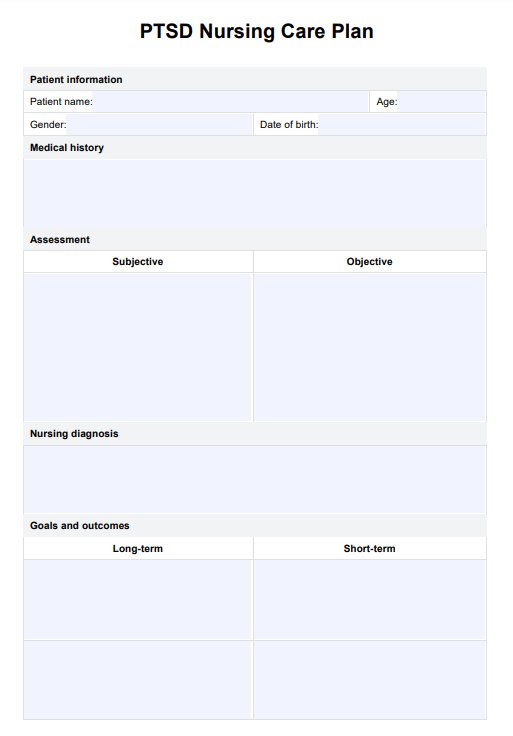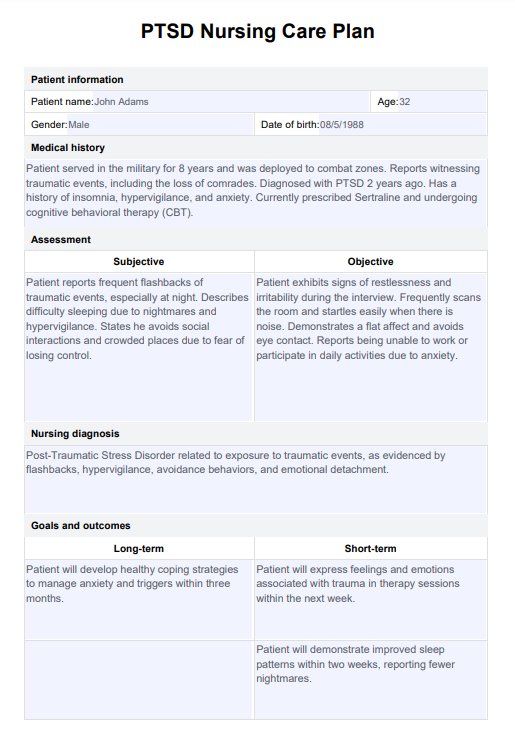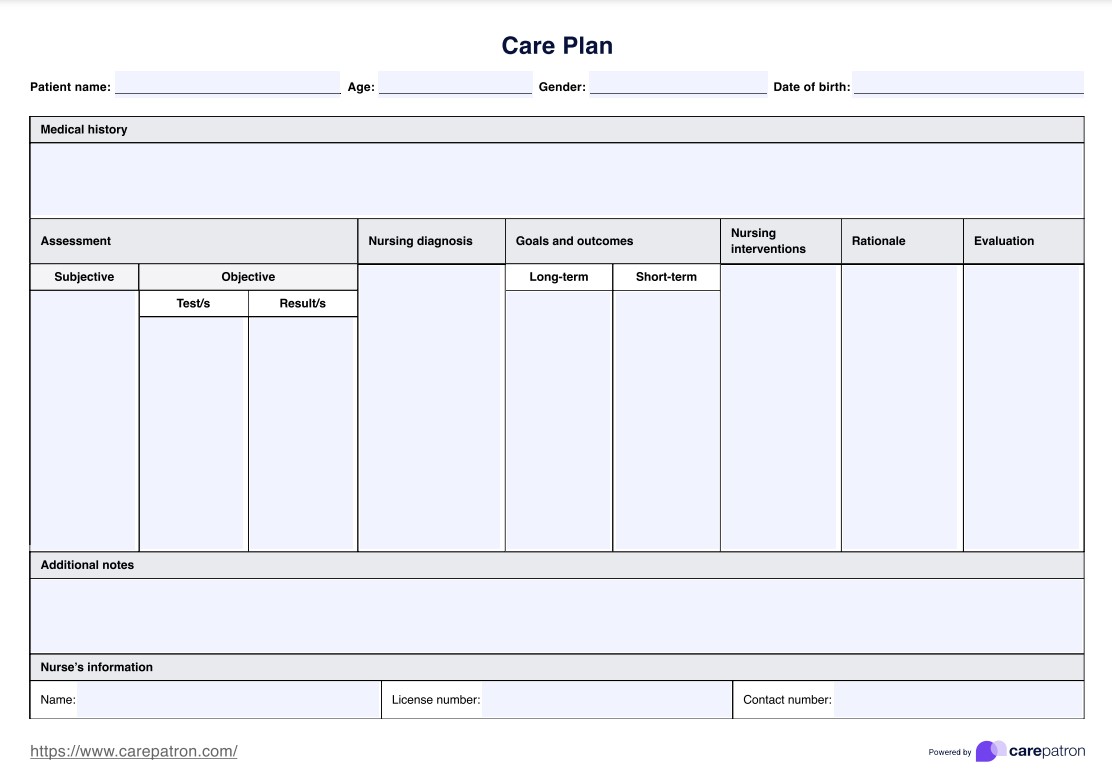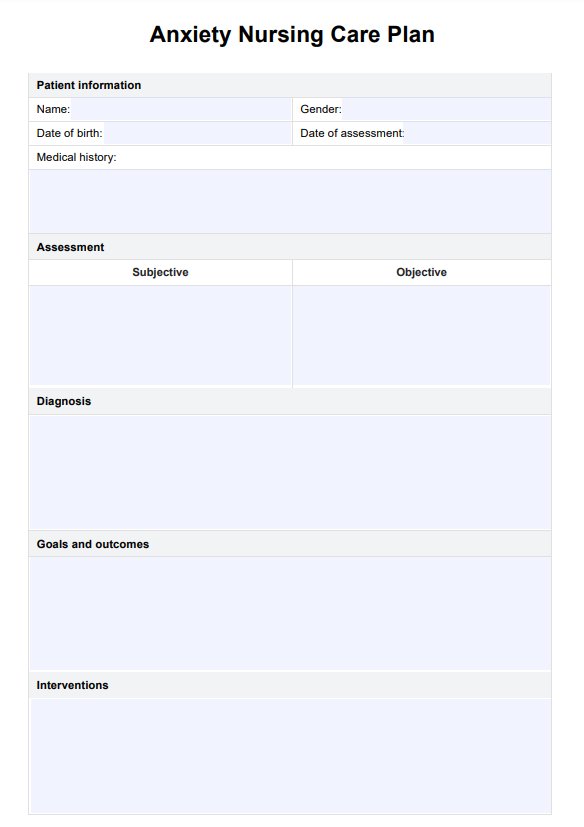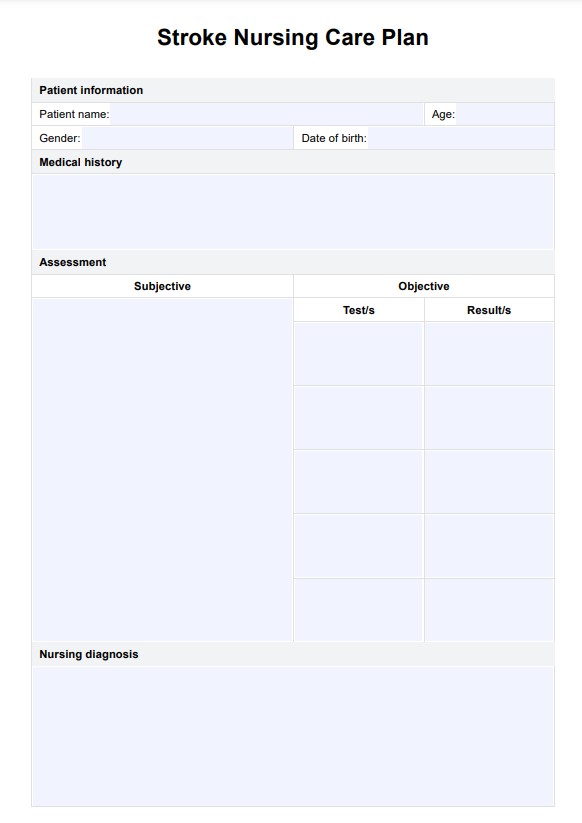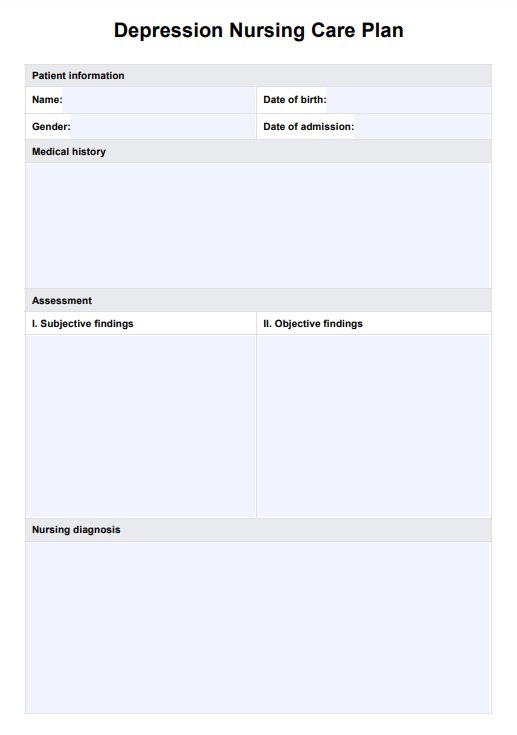PTSD Nursing Care Plan
Master PTSD care with our Nursing Plan Template. Download the free PDF for comprehensive strategies and real-world examples.


What is PTSD?
Posttraumatic stress disorder (PTSD) is a mental health condition that develops after experiencing or witnessing traumatic events, such as military combat, serious injury, accidents, or personal assaults. PTSD is characterized by intense emotional reactions, fear, helplessness, and distress long after the traumatic event, significantly impacting daily life.
Symptoms of PTSD
PTSD symptoms, as outlined in the Diagnostic and Statistical Manual (DSM), are categorized into four main groups:
- Intrusive Thoughts: Recurrent, unwanted memories of the traumatic event, flashbacks, or nightmares.
- Avoidance Behaviors: Actively avoiding reminders of the trauma, including people, places, or activities related to the event.
- Negative Beliefs and Mood: Persistent negative thoughts and emotions, such as guilt, shame, or hopelessness, as well as a lack of interest in activities once enjoyed.
- Changes in Reactivity: Heightened irritability, hypervigilance, difficulty sleeping, or being easily startled.
Treatments for PTSD
Treatment often involves working with a mental health professional to develop healthy coping strategies. Common treatments include:
- Cognitive Behavioral Therapy (CBT): Helps individuals recognize and change negative beliefs and thought patterns stemming from the trauma.
- Exposure Therapy: Gradually exposes patients to their traumatic memories in a controlled environment, reducing avoidance behaviors and the fear associated with the traumatic event.
- Eye Movement Desensitization and Reprocessing (EMDR): Uses guided eye movements to help process and reduce distress related to traumatic experiences.
- Medications: Antidepressants, particularly SSRIs, are often prescribed to manage symptoms of PTSD, improving emotional regulation and mood.
A thorough nursing assessment is crucial in identifying PTSD and establishing an accurate nursing diagnosis. Early intervention and consistent support are essential in helping individuals with PTSD regain control of their lives through structured care and treatment.
PTSD Nursing Care Plan Template
PTSD Nursing Care Plan Example
What is a PTSD Nursing Care Plan Template?
The PTSD Nursing Care Plan Template can help in managing patients with post-traumatic stress disorder. It guides healthcare providers in assessing physical, emotional, and psychological health, identifying key nursing diagnoses such as intrusive memories, avoidance, and mood changes.
The plan sets measurable goals to reduce PTSD symptoms, improve coping strategies, and foster resilience. It includes a range of nursing interventions, like cognitive-behavioral therapy, relaxation techniques, and mindfulness, alongside pharmacological options for severe anxiety. Continuous nursing assessments allow for adaptive care adjustments based on the patient’s progress.
The template also emphasizes psychoeducation for both the patient and their support network to enhance understanding of PTSD. Collaboration with mental health professionals, social workers, and support groups ensures comprehensive care, holistically addressing the patient’s needs. This dynamic, evolving tool is essential for providing personalized care for those dealing with traumatic stress disorder PTSD.
How does it work?
Here are the steps for using a printable PTSD Nursing Care Plan Template:
Step 1: Assessment
Begin by gathering information on the patient's PTSD symptoms, including their severity, duration, and how they affect daily life. Also, explore any relevant risk factors, such as past trauma or pre-existing mental health conditions.
Step 2: Diagnosis
Based on the assessment, determine if the patient meets the criteria for PTSD using established diagnostic tools. Consider utilizing our Post-Traumatic Stress Diagnostic Scale (PDS) to confirm and document the diagnosis accordingly. You can also use resources like our PTSD Worksheet to document findings.
Step 3: Planning
Develop a care plan in collaboration with the patient, setting both short- and long-term goals that are Specific, Measurable, Achievable, Relevant, and Time-bound (SMART). Focus on improving symptom management and quality of life.
Step 4: Intervention
Implement interventions that target the patient’s PTSD symptoms, such as psychoeducation, relaxation techniques, coping strategies, and therapy. Monitor medication adherence if applicable and ensure ongoing support.
Step 5: Evaluation
Regularly evaluate the patient's progress and adjust the care plan as needed based on symptom improvement and patient feedback. This ensures the care plan stays effective and responsive to the patient's needs.
For additional support in your practice, consider our templates for developing effective care plans. Our comprehensive care plan and nursing care plan templates provide structured approaches to patient management and improve outcomes. Explore these resources to enhance your care strategies and documentation processes.
When would you use this template?
When admitting a patient with PTSD to a hospital or healthcare facility, the PTSD Nursing Care Plan Template serves as a valuable resource, enabling healthcare professionals to swiftly and effectively assess the patient's needs. It facilitates the development of a comprehensive plan of care tailored to the individual, considering the unique challenges associated with post-traumatic stress disorder.
In instances where a patient with PTSD experiences a flare-up of symptoms, the template proves instrumental in identifying triggers and devising a targeted plan to help the patient cope. This proactive approach aids in managing acute episodes, fostering a more supportive and responsive care environment.
For those patients requiring ongoing care, the template remains a dynamic tool, allowing healthcare providers to track the individual's progress systematically. Regular assessments ensure that the care plan evolves with the patient's changing needs, promoting continuous improvement and adaptation.
Beyond individual patient care, the PTSD Nursing Care Plan Template extends its utility to education. When educating other healthcare providers about PTSD, the template is an informative teaching tool. It equips providers with a structured understanding of the disorder, offering insights into effective care strategies and fostering a more informed and empathetic healthcare community dedicated to serving patients with PTSD.
Benefits of using the PTSD nursing care plan
The PTSD nursing care plan provides structured support for individuals struggling with PTSD, promoting symptom management and enhancing overall well-being through targeted interventions and resources. Here are the :
- Symptom reduction: Using a nursing care plan can lead to a significant decrease in PTSD-related symptoms, such as anxiety, flashbacks, nightmares, and sleep disturbances, which are common physical manifestations of the condition. This demonstrates the effectiveness of the interventions in managing mental disorders.
- Functional improvement: Enhances the patient’s ability to perform daily activities, engage socially, and maintain employment, indicating improvement despite challenges like ineffective coping and difficulty concentrating.
- Increased self-management skills: Helps patients develop effective coping skills, including relaxation techniques and stress management strategies, allowing them to manage their PTSD symptoms better.
- Improved quality of life: Promotes greater life satisfaction, reduced emotional distress, and increased participation in meaningful activities, reflecting overall well-being and use of community resources.
- Medication effectiveness: Monitors adherence and symptom changes, ensuring medications are prescribed per guidelines.
Commonly asked questions
Coping mechanisms, such as deep breathing and positive self-talk, are effective coping strategies that help PTSD patients manage their anxiety levels and reduce PTSD symptoms, contributing to overall psychological health.
Selective serotonin reuptake inhibitors are commonly prescribed for mood disorders and anxiety management, as they can effectively reduce symptoms of mild anxiety and improve the psychological health of PTSD patients.
Techniques like deep breathing exercises and practicing positive self-talk can help alleviate anxiety levels, providing PTSD patients with effective coping strategies to handle distressing symptoms and improve their overall well-being.


